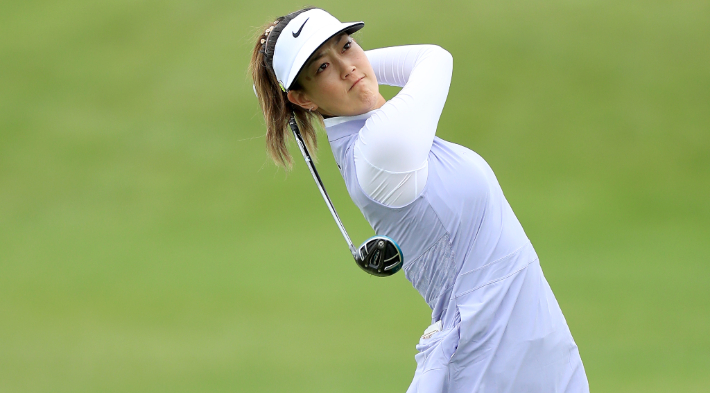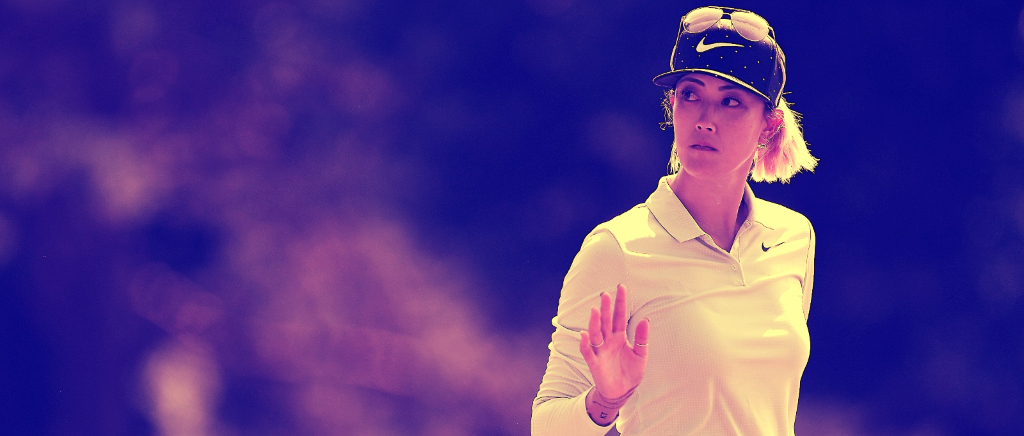Michelle Wie’s been a mainstay in the world of golf for more than a decade. Once the most highly-regarded young golfer in the world following her decision to turn pro when she was 16, Wie’s carved out a steady career on the LPGA Tour, registering more than 60 top-10 finishes and five wins in her career.
Physical fitness plays an important role in Wie’s career, with a wrist injury she suffered as a 17 year old teaching her the importance of adding some type of non-golf exercise early on. Of course, that has been magnified in recent years as her career has progressed and the miles have racked up. Now, Wie is one of the many athletes who agreed to appear on Iron Sharpens Iron, Cam Newton’s Quibi show that features athletes from different sports discussing the methods in which they train — Wie paired up with Olympic gold medalist and beach volleyball great Kerri Walsh Jennings.
Uproxx Sports caught up with Wie to talk her cameo on the show, the role fitness plays in her golf career, the surprisingly similarities between the golf and beach volleyball, and much more.
How did your involvement in Iron Sharpens Iron come about? Did Cam reach out to you directly, or did it happen through some different channels?
My agent actually represents Cam, so I had heard of the opportunity through my agent, which I initially was like, “Wow, this sounds like a really cool idea,” and then especially after I heard about who they paired me up with, I was so excited.
Kerri is a legend. Why were you so excited to work with her?
I mean, like you said, Kerri’s an absolute legend, and just growing up watching her play beach volleyball — I think growing up in Hawaii, we have such a big beach volleyball culture, and as you’ll probably see in the episode, I am not very good. So watching someone on TV, growing up idolizing her, and then just being able to spend one-on-one time with her and her husband on the court was just incredible.
A question or two about golf and just your history with the game as a form of fitness. I think when we think about golf and athletes, it’s something that gets thought of as something that people do on days off, during the summer, those sorts of things. How do you believe golf is beneficial as a form of exercise and cross training for other athletes?
Oh, it’s great. I mean, you hear of golf — like you said, all the football players and a lot of basketball players, they love playing golf, even hockey players, and I mean, tennis too. All other sports, you hear of athletes getting obsessed with the game, actually. I think it’s so great, because I think it allows you to use different muscles. I think being so specialized in one sport, no matter what sport it is, you’re doing the same motion over and over again, and you kind of get stuck in your own ways and stuck mechanically with your body moving in one direction or one way, and that’s definitely how I feel in golf, for sure. So it’s always good to really just change it up. I think it’s really good for your body to do that, and mentally as well too.
I think golf is such a mental sport, and I think people that play a lot of team sports and whatnot, they find this extra challenge in playing golf because it’s such a solo sport, and a lot of the game happens in between your two ears. So I think it’s a great mental challenge. I think it’s a great mental exercise. For walking, I love walking and playing. I mean, a round of golf is about five to six miles. You walk 18 holes, you’re walking six miles a day, which is pretty great. So I think it’s good, I like it, and I think it’s really useful too.
You’ve been playing the game for however many years now, and you turned pro around when you were 16. Plenty of folks think that they’re invincible when they’re 16 years old.
Oh, yeah.
When did your routine start to incorporated more physical stuff so that it wasn’t just, “I’m heading to the range and working on my short game because I’m 16 years old now and don’t have to worry about these fitness-related things”?
I think it happened quickly for me, because I had a pretty big injury when I was 17, 18. So rehab after that, and trying to take my fitness really carefully and cognitively after that was definitely very important to me. But I think taking fitness in general, because even though I had injuries, I was still super limber. My body was doing things without me even thinking about it. I could just go up onto the range and start hitting balls, full shots, and nothing was hurting. Everything was working well, and then all of a sudden you hit later on in your career and you try to do that, and things start cracking that shouldn’t be cracking.
I definitely, within the last couple of years, have really taken fitness seriously. I think I was doing fitness long before, where … we touched base on this in the episode. I was doing really heavy weights and all that, but I think Kerri and I actually, surprisingly, even though how different our sports are, how we train and how we recover and focus on taking care of our bodies are very similar. That’s something that was a definite eye opener for me, and reassured me that I was doing the right thing. If Kerri Walsh Jennings is doing it, then I have to be doing something right.
Could you map out some of those similarities? Any that were, I don’t want to say surprising to you, but like you mentioned, when you found out that Kerri is also doing these sorts of things, you go, “Oh, wow, yeah, I am doing something right”?
I think a big thing in golf is thoracic motion, keeping everything limber, taking care of your shoulders. The shoulder thing wasn’t as surprising, but the thoracic motion, how much she focused on that, was shocking to me, because what you think of volleyball, it’s not a lot of horizontal turning like golf. But you don’t realize how much horizontal turning that they actually do when they serve or when they spike, and they wind up to do a big spike. So that was definitely an eye opener for me, and just how we do stuff, how we train. I really, really enjoyed what she taught me, and yeah, it was a really great day.
Just specifically, what things did you share, or did you want to go in making sure you shared with Kerri, because you thought they could be relevant to her experience as a beach volleyball player?
Well, I mean, I think she was really excited to get golf-specific lessons, because I think her husband plays a lot. So I think she was really excited to learn that aspect of it, which I was really surprised at how quickly she picked it up, as someone that has never played before. She was getting the ball airborne within five minutes, which just shows how great of an athlete she is. But for me, when I actually was filming it, I was going through an injury, so the way we did the episode, I was really focused on recovery and the mental aspect of the game. We did a couple of eye exercises, which I felt were really unique to the game, which you have to have strong eyes to play golf. I think in other sports as well too. You don’t realize that your eyes are muscles, and you have to train them like you would any place else.
You mentioned that you learned about some of the similarities between your two sports while Kerri was going through the things that she was talking about. Was there any new things that you learned about beach volleyball that you went, “Oh, you know what? I can maybe start to incorporate this into my daily routine.”

I think just, some of the workup that she showed me, it was the same thing, but she was doing them differently and approaching them differently and seeing them differently. So a lot of TRX movements that we were doing, a lot of stuff on the physio ball. I want to definitely incorporate more stuff in the sand. I think that the explosiveness of jumping from the sand can really help in golf, and I really feel like if you can do that in the sand, almost using your legs as power on stable grass, I think that would be very beneficial.
Let’s say you get a call and says, “We want to do this again and we want to have you involved again,” who are some athletes whose brains you would love to pick for something like this. Have you ever gotten any particularly interesting tips from someone in another sport that you’ve adopted in the past?
I don’t know. I mean, I would love to pick the brain … I saw Carli Lloyd’s name was on there. Even though we’ve crossed paths a couple of times, but I’d definitely love to pick her brain on what she was thinking when they won the championship, and press situations and stuff like that. I always find it really interesting to talk to athletes about how they handle pressure situation. But yeah, I think if the opportunity came again, I would love to be involved again.
Just a few quick ones here to wrap it up. First things first, something I’m sure that people say to you all the time, I personally am horrific at golf. What is a very simple piece of advice when it comes to hitting a golf ball that you think people can sometimes take for granted?
I think, do less. I think it can get very complicated. So I think just keeping it really simple and still thinking athletic. It’s a really awkward motion for people who don’t play, but like Kerri Walsh Jennings and I were talking about, the setup to the golf swing is the same athletic cluster you would find in almost any other sport. So just bringing it back to athleticism and bringing it back to simple motions and good tempo, I think helps a lot.
I saw that you announced earlier this year, you’re expecting a daughter, and that a goal is wanting her to see you play. What do you need to do to achieve that goal, both in the short and long terms?
I definitely have to get back into playing shape. The injuries that I had that stopped me from playing last year, it was a blessing in disguise. It gave me another year to get better. But I think just really focusing on mental game, being really sharp and focused. I think having a daughter and having that new goal in mind, it definitely puts different perspective on things, and I think it’s going to help me to focus, because it’s a new goal of mine, for sure.







